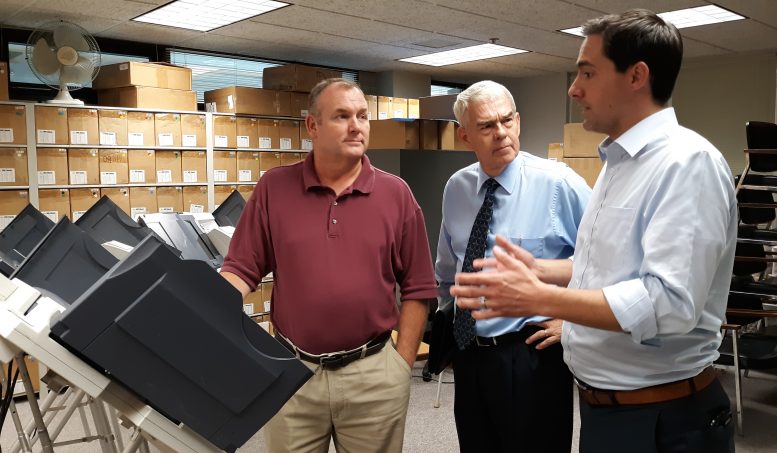By JAN LARSON McLAUGHLIN
BG Independent News
Frank LaRose got a close-up look at the Wood County voting machines that will be replaced next year with funding he pushed through the Ohio Senate.
Wood County’s 12-year-old touchscreen systems are faring better than voting machines in some counties, where spare parts have been scrounged up from Tractor Supply stores or paper clip stashes.
“This is an investment for a long time with the state, so we have reliable, safe machines,” State Senator LaRose, the Republican candidate for Ohio Secretary of State, said Thursday as he stopped in Bowling Green.
Senate Bill 135, sponsored by LaRose, sets aside $114.5 million for new voting machines in Ohio. Wood County’s share is $1.3 million.
The funding for the voting machines comes as the current systems get closer and closer to being obsolete. Wood County’s machines were built in 2006, said Terry Burton, director of the county board of elections..
“In the grand scheme of things, when you’re talking about technology,” the systems are almost antiques. Though Burton credits the local board of elections staff with babying the systems to keep them functioning well.
“Every election, we see a little bit more wear and tear,” Burton said. “It’s time.”
Wood County currently has 575 functional voting machines.
Senate Bill 135 is intended to replace all the voting machines in the state – as long as county boards of election are satisfied with the “Chevrolets” and not the “Cadillacs” of voting machines, LaRose said.
However, in Wood County, Burton said the $1.3 million from the state will be about $3 million shy of the total expected cost of $4.2 million.
“It’s not going to cover it all,” Burton said. “I’ve looked at it all along as a helper. I’m not going to complain about getting $1.3 million.”
Wood County Board of Elections doesn’t want the “Cadillac” of voting systems, but it doesn’t want the “Chevrolet” either, Burton said.
“We’re looking for the SUV,” he said. “We’re looking for a system that’s hardy.”
The total state funding is being divided up among counties based on the number of registered voters and the size of the counties, LaRose said.
Wood County Board of Elections has decided to stick with touchscreen systems, not the optical scans. The touchscreens will be larger and will move more like mobile technology, Burton said.
The Wood County Commissioners have been prepared for the fact that the board of elections will need additional funding to replace the current voting machines. The costs from vendors will not be available till next month, but Burton said the commissioners are aware it may cost the county about $3 million.
“Obviously, we’re going to have a big ask from them,” he said.
“We can get a solid system for a number that we can afford,” Burton said.
All of the voting machines must be converted over at once, since the current ones are 12 years old. “The systems won’t even talk to each other,” he said.
Wood County Board of Elections’ goal is to have the new systems in place for the “manageable” May primary next year.
“We want to have it in place for a while before the presidential election,” Burton said. “By the time we hit the primary in 2020, everything’s figured out.”
State Senator Randy Gardner, R-Bowling Green, agreed the system should be tested out before the presidential election.
“The whole world will be watching Ohio in the 2020 election,” he said.
Still under consideration locally is the number of voting machines needed in Wood County, Burton said. By law, the board of elections must have one machine for every 175 registered voters at a polling location.
In order to save on voting machines, and polling volunteers, the county may consolidate some polling sites, Burton said.
“We’re looking at regionalizing where we can,” he said.
Currently, there are 15 single precinct locations in the county. Some of those may be absorbed by other sites.
“The rural areas are going to feel it a little more because of the miles,” Burton said.
After viewing the voting machines at the Wood County Board of Elections, LaRose talked about other issues pertinent in his race for Secretary of State.
The current rules used by Ohio to purge voters from the rolls need to be changed, LaRose said.
“It is an outdated process,” he said, one used for decades. “It’s using a blunt instrument for the job of keeping lists.”
The issue is not political, LaRose said, objecting to the use of the word “purge.” If done correctly, it’s an issue of maintaining accurate voting rolls.
“We want to maintain accurate lists. We also don’t want to remove Ohio voters from the rolls,” he said, suggesting that Ohio study the creation of automated voter registration. “We need to have that thoughtful conversation and change it.”
LaRose also shares the viewpoint of his Democratic opponent Kathleen Clyde that voter fraud is more rhetoric than reality.
“It’s always something to be concerned about” because it causes people to lose trust in the system, he said. “But it’s also extremely rare.”
But too often, Republicans talk about widespread fraud and Democrats talk about widespread voter suppression.
“That’s deeply irresponsible. We need to be responsible about our rhetoric,” he said. “It makes the average person less likely to participate.”
LaRose served in the U.S. Army for 10 years, including tours as a Green Beret in Iraq and Kosovo.
“When you see people risk their lives to vote – which I have seen – it’s something you remember,” he said.
Since 2011, he has served as state senator from Wayne County and parts of Stark and Summit counties.
LaRose also touched on the other primary role of the Secretary of State’s Office, dealing with new businesses.
“I will be an advocate for small businesses in state government,” he said, including working on regulatory reform.





